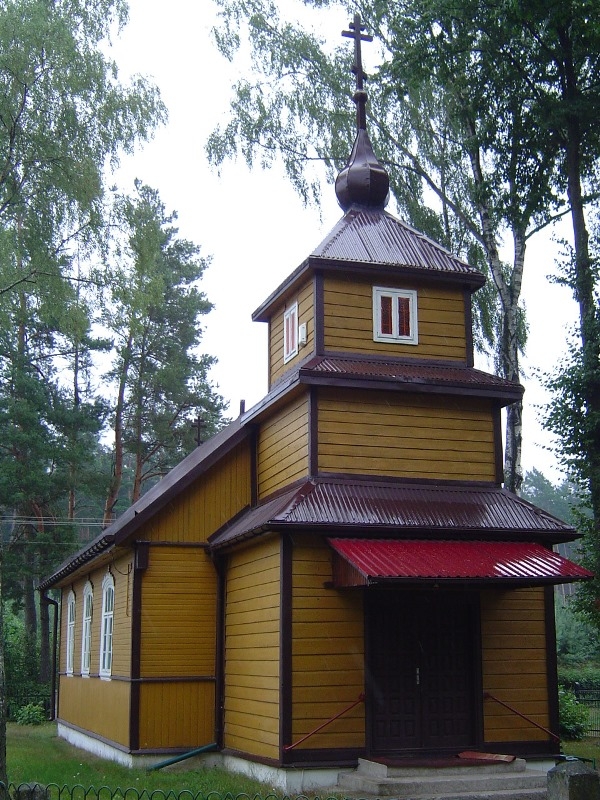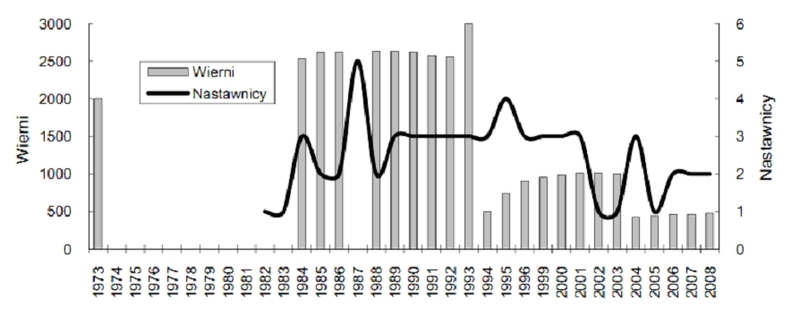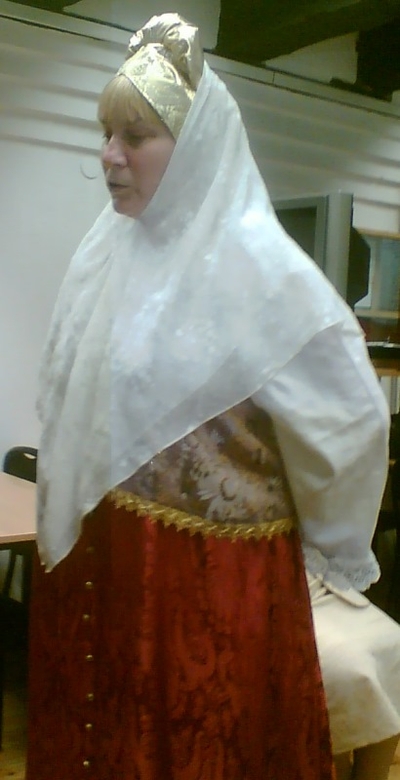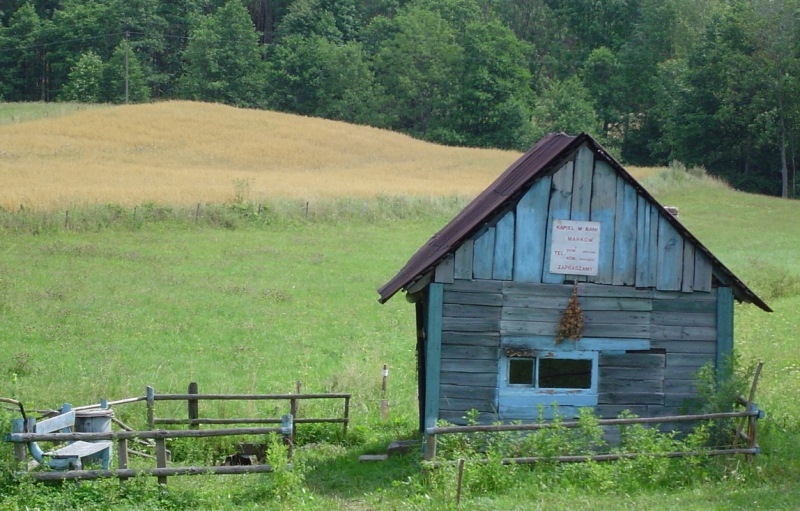Russian of Old Believers
Statistics/speakers' characteristics
Statistics
In its different varieties, Russian is spoken as a first language by 145 million people in the world. The overall number of speakers (including those who use Russian as a second or foreign language) comes to 300 million (Witkowski 2011: 111 Witkowski 2011 / komentarz/comment/r /
Witkowski 2011 / komentarz/comment/r / Witkowski, Wiesław 2011. „Język rosyjski”, w: Barbara Oczkowa & Elżbieta Szczepańska (red.) Słowiańskie języki literackie. Rys historyczny. Kraków: UJ, s. 111-126.
 ).
).
A molenna in Gabowe Grądy – photo by T. Wicherkiewicz.
According to the data of the Central Statistical Office for the year 2008, the number of the Old Believers consists of 480 people but these data concern only the Gabowe Grądy parish (Gudaszewski i Chmielewski 2010: 51
 Gudaszewski i Chmielewski 2010 / komentarz/comment/r /
Gudaszewski i Chmielewski 2010 / komentarz/comment/r / Gudaszewski Grzegorz & Mariusz Chmielewski (red.) 2010. Wyznania religijne. Stowarzyszenia narodowościowe i etniczne w Polsce 2006-2008. Warszawa: ZWS. [http://www.stat.gov.pl/cps/rde/xbcr/gus/oz_wyzn_rel_stow_nar_i_etn_w_pol_2006-2008.pdf]
 ). According to the Statistical Yearbook for 1993, the number was as high as to 2560 people; in later years, there appears a sudden breakdown in the Central Statistical Office data, as illustrated in the picture below.
). According to the Statistical Yearbook for 1993, the number was as high as to 2560 people; in later years, there appears a sudden breakdown in the Central Statistical Office data, as illustrated in the picture below.

The number of the Old Believers according to the data of the Central Statistical Office (Gudaszewski i Chmielewski 2010: 51
 Gudaszewski i Chmielewski 2010 / komentarz/comment/r /
Gudaszewski i Chmielewski 2010 / komentarz/comment/r / Gudaszewski Grzegorz & Mariusz Chmielewski (red.) 2010. Wyznania religijne. Stowarzyszenia narodowościowe i etniczne w Polsce 2006-2008. Warszawa: ZWS. [http://www.stat.gov.pl/cps/rde/xbcr/gus/oz_wyzn_rel_stow_nar_i_etn_w_pol_2006-2008.pdf]
 ).
).According to the calculations by Z. Jaroszewicz-Pieresławcew published in 1995, the total number of the Old Believers equals 952 (Zielińska 1996: 28
 Zielińska 1996 / komentarz/comment/r /
Zielińska 1996 / komentarz/comment/r / Zielińska, Anna 1996. Wielojęzyczność staroobrzędowców mieszkających w Polsce. Warszawa: Slawistyczny Ośrodek Wydawniczy.
 ).
).It should be emphasised that creed-related statistics do not reflect how many people use the language varieties discussed here.
According to the register of the Old Believers' religious communities prepared for the 2nd Polish Ecumenical Council in 1988, 854 people at that time were members of the Suwałki parish, 138 of the Wodziłki parish, 1207 of the Gabowe Grądy parish, 428 of the Wojnowo parish (Zielińska 1997: 159
 Zielińska 1997 / komentarz/comment/r /
Zielińska 1997 / komentarz/comment/r / Zielińska, Anna 1997. „Elementy gwary rosyjskiej w polszczyźnie staroobrzędowców”, w: Feliks Czyżewski & Michał Łesiów (red.) Ze studiów nad gwarami wschodniosłowiańskimi w Polsce. Lublin: Wydawnictwo UMCS, s. 159-167.
 ).
).According to the Russian Empire census from 1897, the number of the Old Believers in the Augustów, Suwałki and Sejna regions comprised of 5450. According to the 1921 Polish census, their number equalled 2800. After World War II, there were approximately 1500 Old Believers in the Białystok region (Grek-Pabisowa i Maryniakowa 1972: 114
 Grek-Pabisowa i Maryniakowa 1972 / komentarz/comment/r /
Grek-Pabisowa i Maryniakowa 1972 / komentarz/comment/r / Grek-Pabisowa Iryda & Irena Maryniakowa 1972. „Teksty gwarowe rosyjskie”, w: Antonina Obrębska-Jabłońska (red.) Teksty gwarowe z Białostocczyzny z komentarzem językowym. Warszawa: PWN, s. 113-131.
 ).
).
#illustration# The traditional dress of an Old Believer woman, photo by T. Wicherkiewicz.
Other languages used by the speakers
Just as their environment, speakers of Russian dialects of the Old Believers use Polish. As Zielińska wrote in 1996, at that time the Polish language of the old generation was similar to a local dialect variety (the Suwałki Mazurian dialects and the Suwałki-Sejny nonmazuring dialects in the Suwałki-Sejny centre, and the Masurian dialect in the Masurian centre). The Polish language of the young generation is more similar to standard Polish. Polish spoken by this community remains under the influence of Russian and, in the Masurian centre, German. It is worth mentioning that the Old Believers knew Polish at the moment of their arrival in Prussia (the Masuria) in 1830, and with time they also got to know German. After World War I there occurred a complete cultural turn towards German, along with a denial of Polish (Zielińska 1996: 43-45 Zielińska 1996 / komentarz/comment/r /
Zielińska 1996 / komentarz/comment/r / Zielińska, Anna 1996. Wielojęzyczność staroobrzędowców mieszkających w Polsce. Warszawa: Slawistyczny Ośrodek Wydawniczy.
 ).
).The Polish dialect used by the Old Believers remains under the influence of the Russian dialect. Some phenomena should be featured: the asynchronic articulation of nasal sounds even before fricatives (i.e. monš 'husband', genśi 'geese'), denasalisation (the loss of nasal articulation) in rhyme (i.e. našo v́are '[acc.] our faith', źimovo poro '[instr.] winter time') or the lack of sound exchange [k : c] (i.e. in dative singular form: matk'e 'mother', vnučk'e 'granddaughter' or in nominative plural: Polak'i 'Poles', robotńik'i 'workers') (Zielińska 1997: 64
 Zielińska 1997 / komentarz/comment/r /
Zielińska 1997 / komentarz/comment/r / Zielińska, Anna 1997. „Elementy gwary rosyjskiej w polszczyźnie staroobrzędowców”, w: Feliks Czyżewski & Michał Łesiów (red.) Ze studiów nad gwarami wschodniosłowiańskimi w Polsce. Lublin: Wydawnictwo UMCS, s. 159-167.
 ).
).In the 1950s, the Old Believers from the Masurian centres were still using German with dialectal elements and also Low German dialect in the West of Masuria. In that period, the older informants knew German poorly while the younger poorly knew the Polish dialect: they used standard German or standard Polish (Siatkowski 1983: 104
 Siatkowski 1983 / komentarz/comment/r /
Siatkowski 1983 / komentarz/comment/r / Siatkowski, Janusz 1983. „Interferencje językowe na Warmii i Mazurach”, w: Studia z Filologii Polskiej i Słowiańskiej XXI: 103-115.
 ).
).The Old Believers' liturgy uses Church Slavonic. Moreover, the dialect incorporates Church Slavonic sentences borrowed from the Bible or the liturgy.
Church Slavonic remains the language of liturgy in cities but the Old Believers dialect, Polish and even standard Russian are also used in religious sphere (Głuszkowski 2011: 139-142
 Głuszkowski 2011 / komentarz/comment/r /
Głuszkowski 2011 / komentarz/comment/r / Głuszkowski, Michał 2011. „Język religii i jego znaczenie dla zachowania tożsamości przez polskich staroobrzędowców”, w: Ewa Golachowska & Anna Zielińska (red.) Konstrukcje i destrukcje tożsamości. Wokół religii i jej języka. T. 1. Warszawa: Slawistyczny Ośrodek Wydawniczy.
 ).
).Families of Old Believers adopt various strategies while bringing up their children. Polish is regarded as a language giving an opportunity for social and economic promotion and the Russian dialect is important in religious activities. One of the tactics is speaking Polish at home and Russian at the grandparents', another involves one parent being the Polish speaker and the other being the Russian speaker.

A village Old Believers' banya in Wodziłki in the Suwałki region, photo by T. Wicherkiewicz.
ISO Code
| ISO 639-1 | ru |
| ISO 639-2 | rus |
| ISO 639-3 | rus |
| SIL | RUS |
- przyp01
- Zielińska 1999
- Wicherkiewicz 2000
- Crummey 1998
- Abramow i Abramowa 2009b
- Witkowski 2011
- Zalizniak 2004
- Grek-Pabisowa 1997
- Tetzner 1902
- Palikowa i Rostowa 2008
- Zielińska 1996
- Grek-Pabisowa i Maryniakowa 1972
- Sosna i Troc-Sosna 2002
- Kisin 2012
- Ledieniewa i Wojłowa [?]
- Gudaszewski i Chmielewski 2010
- Zielińska 1997
- Siatkowski 1983
- Głuszkowski 2011
- List of declarations 2012
- Abramow i Abramowa 2009a
- Grek-Pabisowa i Maryniakowa 1980
- Palikowa i Rownowa 2008
- Lewis 2009
- Rykała 2011
- zagrożenie języków / language endangerment
- Osady staroobrzędowców w Polsce
- Gramota na korze brzozowej
- Wsie Staroobrzędowców na Mazurach
- Półustaw - krój pisma cyrylicznego
- Wczesny tekst cyryliczny wydrukowany grażdanką
- Liczba osób wyznania staroobrzędowego
- Okładka słownika gwary polskich Staroobrzędowców
- Słownik dialektu Staroobrzędowców Estonii
- Tekst modlitwy 'Ojcze nasz'
- Tablica na Naczelnej Rady Staroobrzędowców
- Tablica informacyjna na molennie w Suwałkach
- Panorama Wodziłek
- Starowierki (z Łotwy) w tradycyjnych strojach
- Centrum wsi Wodziłki
- Księga liturgiczna Staroobrzedowców z Wojnowa
- Molenna w Gabowych Grądach
- Tradycyjny strój Starowierki
- Wiejska bania w Wodziłkach
- Współczesny nagrobek Staroobrzędowców w Wodziłkach
- Księga liturgiczna i modlitewne czotki
- Była molenna Staroobrzędowców w Gibach
- Molenna cmentarna w Suwałkach